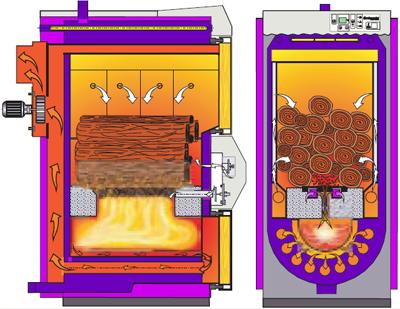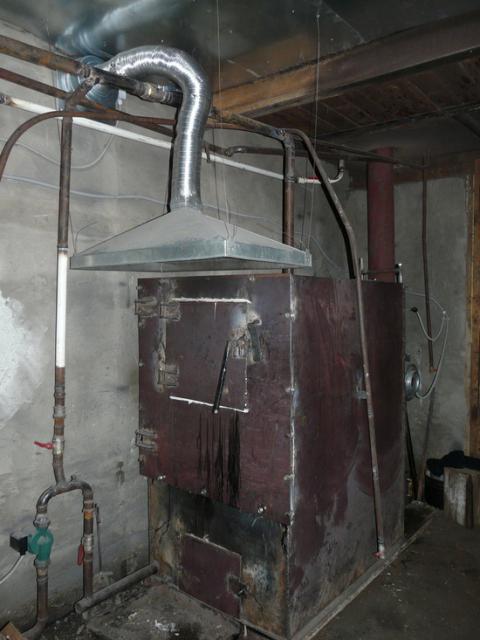Boiler diagram
In recent years, the issues of ensuring the energy efficiency of houses have left the realm of theoretical calculations and have become a practical task for every homeowner. The easiest way to reduce heating costs was the equipment of autonomous systems. In gasified areas, the problem is solved simply - by installing a gas boiler.
In non-gasified areas, the problem must be solved in other ways, taking into account the available type of fuel, usually coal, firewood or pellets. As a result, homeowners have turned their attention to boilers that run on these types of fuels. Their important advantage is the simplicity of design. At the same time, a do-it-yourself manufacturing scheme and drawings for it can be easily made by a home master.
Types of boilers
There are several types of solid fuel boilers. We’ll make a reservation right away that not all of these types are suitable for making with your own hands, since some of them have a very complex design.
All existing varieties can be divided into two large groups:
- Classic.
- Pyrolysis.
They are also classified according to other parameters - the direction of fuel combustion, the number of circuits, etc. Important distinguishing features can be considered the power, size and method of installation of the unit.
Pyrolysis
Their work is based on the principle of pyrolysis. Fuel in such a boiler burns slowly. Low air supply and high combustion temperatures lead to the formation of combustible gases, due to which the efficiency of the unit increases.
Long-burning pyrolysis boilers have a complex design, so it is not always possible to make them yourself. However, difficult does not mean impossible. With the availability of materials and experience, it is possible to create an efficient heat source operating on the pyrolysis principle.
Classic
The classic boiler is quite simple. By design, it resembles a conventional wood-burning stove, differing from it in a lower rate of fuel combustion. It is these options that are most often installed in home-made boiler rooms.
Important! Their popularity is explained not only by their structural simplicity, but also by the possibility of installing a second circuit for supplying hot water.
A classic wood-burning boiler without a hot water circuit can be made from any metal barrel or a piece of steel pipe. In the lower part, a furnace is made where solid fuel is burned - coal, firewood, pellets, sawdust, etc. In fact, such a boiler is an improved stove-stove. However, it surpasses the latter in terms of heating efficiency and efficiency. The simplicity of the design allows it to be installed not only in autonomous heating networks of country houses, but also for heating garages, greenhouses, utility rooms, etc.
Long-term combustion of solid fuel in such boilers is ensured by a water circuit that acts as a heat exchanger. According to the method of combustion, the boiler can be:
- With bottom burning.
- Top burning.

Classic solid fuel boilers
In boilers of the first type, the burning rate is regulated by the force of air supply through the blower. In the simplest home-made designs, adjustment is carried out manually, and in more complex industrial units, it is automatic. To increase the efficiency, it is necessary to make the heat exchanger area as large as possible. This allows you to increase the capacity of the furnace and the amount of fuel loaded into the boiler at a time. As a result, it can operate without refueling for about half a day.
The top combustion unit is more productive. The fuel in it burns not only slowly, but evenly. Industrial units of upper combustion on one tab of firewood are able to work on average for two days. Coal structures on one portion of fuel can function for about a week. Of course, the cost of such a boiler is very high, which makes it inaccessible to a significant part of consumers. On the other hand, despite the greater complexity of the design compared to the classic lower combustion boiler, it is quite suitable for self-production.
Mine
An interesting variety that can be easily designed and made by hand. The main advantage of mine boilers is the ability to adjust to any type of solid fuel. They work equally well and efficiently on both coal and wood or pellets.
The efficiency of the unit is at least 75%, power - 15–20 kW. For heating a small country house, such characteristics, as a rule, are enough.
We build a classic boiler

Long burning furnace
It is necessary to start manufacturing the boiler with calculations and the implementation of drawings, diagrams, or at least sketches. Calculations allow you to determine the required power of the unit, and therefore, to identify such important parameters as the volume of the furnace, the area of \u200b\u200bthe heat exchanger, the volume of a single load, etc. Drawings can be found on the net or drawn independently. To create the simplest design, a small sketch may be enough.
The best option is the manufacture of a classic boiler. After all, it is extremely difficult to develop an effective and reliable pyrolysis boiler without experience and skills. The basis of the unit body can be a pipe or a welded structure made of sheet steel. It all depends on the availability of opportunities and the developed project.
The work is carried out in several stages:
- Body welding.
- Manufacture of an air diffuser. For this purpose, a small piece of pipe with a damper is welded in the upper part to regulate the air supply to the furnace. An impeller can be additionally installed in the lower part of the distributor.
- Formation of an ashpit and firebox, installation of doors and other fittings.
- Installing the cover on the top of the case.
- Installation of the finished boiler on a concrete foundation.
- Connection to the water circuit.
- Accelerating firebox.
If the design is done correctly, and there were no errors when connecting the unit to the fuel network, the accelerating furnace passes without problems. This means that the boiler can be operated without fear.
Accelerating firebox

Homemade from sheet steel
It is necessary to heat the boiler for the first time before the onset of the heating season - in case of errors, there will be time to correct them. Such a unit is able to work on any type of solid fuel. Choose the one that you plan to use constantly. Fuel is loaded through the top cover of the housing. The furnace must be filled up to the level of the chimney. For better combustion, you can spray the load with a special ignition fluid.
At the end of loading, the lid closes and the air supply regulator returns to its place. One of the disadvantages of this design is that it is impossible to remove the top cover without removing the air regulator.
Ignition is carried out through an open air damper using a burning splinter. Until the fuel begins to smolder confidently, the damper should remain open. She then covers up a bit. When the combustion rate drops to a level insufficient for efficient operation, the damper can be slightly opened. With an accelerating furnace, the fuel in the boiler must completely burn out.
Homemade pyrolysis units

Do-it-yourself pyrolysis boiler
The main difference between a pyrolysis boiler and a classic one is the presence of two combustion chambers. In the first, the process of fuel combustion takes place, and in the second, the released pyrolysis gases. A grate is installed between the chambers. For a pyrolysis boiler, oxygen supply is important. Forced air injection can be carried out using a fan and simple automation.
It is better to take from reliable sources. You can develop them yourself only if you have such skills. If necessary, changes can be made to the finished drawings, thanks to which the boiler will be ideally suited to specific operating conditions. The simplest version of a home-made pyrolysis unit with a power of about 40 kW can be assembled on the basis of the Belyaev boiler.
Conclusion
A do-it-yourself solid fuel heating boiler is a reality. The drawings available on the network, the availability of skills, the simplest tools and materials - this is the minimum that allows you to create a reliable and efficient heating network in a country house, putting energy-efficient heating into practice. And all this together will make it possible to significantly reduce the cost of maintaining the house.